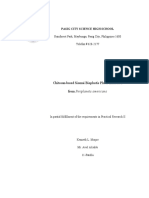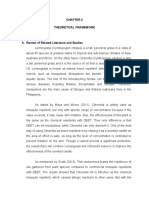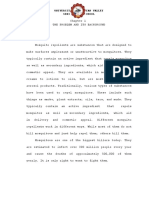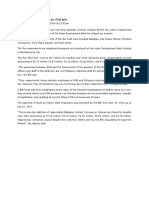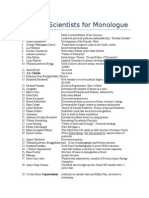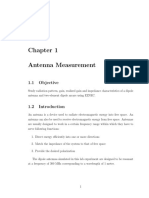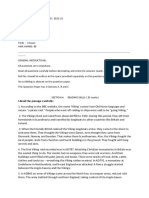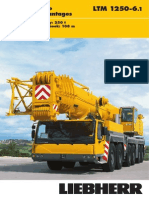RRL
RRL
Uploaded by
Katrina Anne Layson Yeen0 ratings0% found this document useful (0 votes)
932 views9 pages......
Original Title
rrl
Copyright
© © All Rights Reserved
Available Formats
DOCX, PDF, TXT or read online from Scribd
Share this document
Did you find this document useful?
Is this content inappropriate?
Report this Document......
Copyright:
© All Rights Reserved
Available Formats
Download as DOCX, PDF, TXT or read online from Scribd
Download as docx, pdf, or txt
0 ratings0% found this document useful (0 votes)
932 views9 pagesRRL
RRL
Uploaded by
Katrina Anne Layson Yeen......
Copyright:
© All Rights Reserved
Available Formats
Download as DOCX, PDF, TXT or read online from Scribd
Download as docx, pdf, or txt
You are on page 1of 9
From the second half of the XX century, the
agricultural modernization has focused on using new
techniques which aim to increase the food production
for the ever-growing human population (Iannacone et
al., 2005). The increase on the food production is
owned to the scientific breakthroughs and
technological innovations which include developing
new plant varieties, the increase of irrigation facilities
and the use of fertilizers and pesticides (Gliessman,
2002). The use of the monoculture has brought as a
consequence, the use of synthetic insecticides, which
reduce the biodiversity of agroecosystems, provoking
their instability (Gliessman, op. cit.) and cause harmful
effects, such as: environmental pollution, human
health issues (Hilje, 2001), insect resistance to
pesticides (Denholm et al., 1998), natural pest
predators (Aggarwal and Brar, 2006), parasitoids
(Iannacone and Lamas, 2003) and pollinators
(Desneux et al., 2007) loss.
As a consequence of these environmental security and
health issues (Karunamoorthi et al., 2008), nowadays,
new strategies for pest insects control which are less
hazardous and more environmentally friendly are
searched for; such as the use of plant extracts, one of
the most attractive methods for this aim (Salvadores et
al., 2007).
The practice of using plant extracts in agriculture for
pest control is not new; it has been used for at least
two millennia, when botanical insecticides were
considered important products for pest management in
Ancient China (Long et al., 2006), Egypt, Greece and
India (Isman, 2006). Even in the United States and
some European countries, botanical insecticides were
predominantly used, before the discovery of
organochlorated and organophosphorated insecticides
in the late 1930s and early 1940s (Isman, 1997).
In the last 30 years, there has been an increasing
research on plant extracts (Clemente et al., 2003), due
to the numerous problems that synthetic insecticides
cause; leading to what could be considered a second
era of the botanical insecticides (Silva et al., 2002).
The plants that present biological activity against
insects owe this feature to the presence of secondary
metabolites (Garca et al., 2004), some of which have
been widely investigated (lvarez et al., 2007;
Salvadores et al., 2007; Chandra et al., 2008). The
process of knowing and obtaining secondary
metabolites against insects is by means of plant
extracts, which can have variations; sometimes
aqueous extracts can be obtained (Bobadilla et al.,
2005), solvents can be used to obtain different
compounds depending on their polarity (Bobadilla et
al., 2002), essential oils can also be obtained (Prez et
al., 2004), or dehydrated plant parts to be used as
powders (Silva et al., 2003).
Secondary metabolites feature several properties
against insects, like insecticidal activity (Cavalacante
et al., 2006), considered as that substance or mixture
of substances that exert biocide action due to the
nature of their chemical structure (Celis et al., 2008).
However, most of the plants used against insects have
an insectistatic effect, rather than insecticidal. This
refers to the inhibition of the insects development and
behavior (Celis et al., 2008), and it is divided into:
Repellence (Viglianco et al., 2006), anti-feeding
activity (Eriksson et al., 2008), growth regulation
(Wheeler and Isman, 2001), feed deterrents (Koul,
2004), and oviposition deterrents (Banchio et al.,
2003).
Repellent activity is presented in plants that have
compounds with fowling odor or irritating effects,
which cause insects to get away from them (Peterson y
Coats, 2001). Anti-feeding activity is exerted by
compounds that once ingested by the insect, causes it
to stop feeding and eventually die of starvation (Isman,
2006). Growth regulating compounds inhibit
metamorphosis or provoke precocious molting. They
alter the growth regulating hormones and cause
malformations, sterility or death in insects (Celis et al.,
2008).
To the present, there are more than 2000 plant species
known to have insecticidal properties, where the
Euphorbiaceae, Asteraceae, Labiatae, Fabaceae,
Meliaceae and Solanaceae families stand out (Garca
et al., 2004). Among the metabolites with biological
activities against insects, flavonoids, terpenoids,
alkaloids, steroids and phenols stand out (Orozco et
al., 2006).
Three plant families that draw attention as promising
sources of insecticidal compounds are: Annonaceae,
Solanaceae and Meliaceae. These families have been
selected to be studied for the following reasons: 1)
they possess different chemical groups for insect
control; 2) they are common families in the tropics and
are cultivated in various regions; 3) there is research
that have shown biological activity against insects and
are highlighted as potential plants for their use in the
tropics.
The objective of the present work is to revise literature
on different plant extracts from the Annonaceae,
Meliaceae and Solanaceae families, the compounds or
mixtures of compounds obtained as well as their
modes of action against insects.
The Annonaceae family has drawn a lot of attention
since the 1980s, due to the presence of acetogenins, of
which their structural characteristics feature a variety
of biological activities, where the insecticidal activity
stands out (Ocampo and Ocampo, 2006).
Among the Annona genus, two species stand out for
their insecticidal properties, Annona muricata L. and
Annona squamosa L. the acetogenines found in A.
muricata include: annocatalin, annohexocin,
annomonicin, annomontacin, annomuricatin,
annomuricin, annonacin, coronin, corossolin,
corossolone, gigantetrocin, gigantetronenin,
montanancin, muracin, muricatalicin, muricin,
robustosin, solamin, squamocin, uvariamicin, among
others (Raintree Nutrition, 2004).
Regarding their structure, the acetogenins comprise a
series of natural products C-35/C-37 derived from C32/C-34 fatty acids combined with a 2-propanol unit
(Alali et al., 1999). The acetogenins are found in
leaves, branches and mostly in seeds of annonaceous
plants, and A. muricata has been the most widely
studied species (Table 1). From the wide variety of
acetogenins, squamocin and annonacin have shown the
highest impact on insects (lvarez et al., 2008).
Acetogenins block the respiratory chain at NADH
ubiquinone reductase (Complex I) and cause a
decrease in ATP levels, affecting directly the electron
transport in the mitochondria, causing apoptosis (Alali,
et al., 1999). The annonaceous extracts have been
evaluated in several groups of insects of both medical
and agricultural importance. Among the agricultural
pests, chewing insects like Lepidoptera larvae
(Laetamia e Isman, 2004; lvarez et al., 2007), and
sap sucking like Myzus persicae S. (Guadao et al.,
2000) can be found. Among the human health related
insects, blood sucking insects can be found, such as
the Aedes aegypti L, mosquito, dengue fever and
yellow fever vector in tropical areas (Domnguez et
al., 2003; Bobadilla et al., 2005).
The solvents used for extracting acetogenins are
varied such as: water (Prez-Pacheco et al., 2004),
ethanol (Bobadilla et al., 2002), acetone
(Khalequzzaman and Sultana, 2006), chloroform
(Parvin et al., 2003), petroleum ether (Alvarez et al.,
2008) and hexane (Fontana et al., 1998). From this
information, it can be inferred that acetogenins can
range from very polar, such as those extracted by
water and ethanol, to non polar, which are extracted by
hexane; however, if a rational management of natural
products is desired, it is recommended the use of the
more polar extracts (Bobadilla et al., 2005).
The extracts have been dissolved with acetone
(Khalequzzaman and Sultana, 2006) and distilled
water (Prez Pacheco et al., 2004); although they can
be dissolved with other substances such as
dichloromethane, dimethyl sulfoxide, ethanol or
Tween 20. The criteria for choosing the solvent is
focused on the least negative effect over the studied
organism, obtaining thus an adequate for the plant
extracts or secondary metabolites to be evaluated
(Carvalho, 2008).
Plant alkaloids have been found to affect
physiological systems in higher animals as well
as in insects (Saxena and Tikku 1990). Schneider
et al. (1982) have mentioned that these
compounds in general are very toxic to insects
and can be used as insecticides.
Some plants known to contain toxic principles
can play a useful role in the control of vectors.
A variety of plant species of different families
have been reported to exhibit insecticidal and
other biological activities (Jotwani and Srivastava
1981, Banerji et al. 1985, Kalyanasundaram
and Das 1985, Saxena and Sumithra 1985,
Chavan and Nikam 1988, Saxena and Saxena
1992, Saxena et al. 1992).
Since, Annond squan'Losa (Family Annonaceae)
extracts have shown insecticidal activity
against stored grain insects (Dixit 19921), we
deemed it appropriate to study the larvicidal
and chemosterilant activity of A. squamosa alkaloids
against Anopheles stephensi Liston, an
important urban vector of malaria in India.
You might also like
- Steinbeck John The PearlDocument79 pagesSteinbeck John The PearlDaríoManuel100% (11)
- 2.petrochemical - Olefins, Synthesis GasDocument122 pages2.petrochemical - Olefins, Synthesis GasAn Lê Trường100% (1)
- Converting Oregano Leaves Into A Natural Mosquito CoilDocument44 pagesConverting Oregano Leaves Into A Natural Mosquito CoilAngel Jimmyly EstanillaNo ratings yet
- Cymbopogon Citratus (Lemon Grass), Garlic Clove Skin, and Azadirachta Indica (NeemDocument29 pagesCymbopogon Citratus (Lemon Grass), Garlic Clove Skin, and Azadirachta Indica (NeemJohn Drake TagavillaNo ratings yet
- Infused Santan Oil Please Dont EraseDocument12 pagesInfused Santan Oil Please Dont EraseMg Fantillan50% (2)
- Rainforest Park, Maybunga, Pasig City, Philippines 1600 Telefax # 628-2177Document37 pagesRainforest Park, Maybunga, Pasig City, Philippines 1600 Telefax # 628-2177Kenneth L. MaqueNo ratings yet
- 12 - EMERGENCY RESPONSE PROCEDURE Annex BuildingDocument16 pages12 - EMERGENCY RESPONSE PROCEDURE Annex BuildingYousaf RichuNo ratings yet
- The Feasibility of Adelfa Nerium Oleander Leaves As A Termiticide To Drywood Termites Cryptotermes BrevisDocument2 pagesThe Feasibility of Adelfa Nerium Oleander Leaves As A Termiticide To Drywood Termites Cryptotermes BrevisChristine P. AragNo ratings yet
- Chapter IIDocument7 pagesChapter IIMark PollenteNo ratings yet
- Pandan Mosquito Coil PDFDocument19 pagesPandan Mosquito Coil PDFJOHN CARLO LORBISNo ratings yet
- HuvDocument28 pagesHuvcorazon e. unabiaNo ratings yet
- Final Draft I.P.Document15 pagesFinal Draft I.P.essira100% (4)
- REVISED ResearchChapter2Document5 pagesREVISED ResearchChapter2JB TuganoNo ratings yet
- Chapter 03Document4 pagesChapter 03Marlou Felix Suarez Cunanan100% (1)
- Investigatory ProjectDocument12 pagesInvestigatory Projectellaine0% (1)
- Chili Pepper LeavesDocument7 pagesChili Pepper LeavesCamille ManlongatNo ratings yet
- Chapter 1Document4 pagesChapter 1Samdenver AbrazadoNo ratings yet
- UntitledDocument49 pagesUntitledJhanella Marie DalmanNo ratings yet
- Summary, Conclusions, and RecommendationsDocument5 pagesSummary, Conclusions, and RecommendationsJamie BagundolNo ratings yet
- Background of The StudyDocument4 pagesBackground of The Studysaraheyyy100% (1)
- 1 Potency of Oregano (Origanum Vulgare) and Basil (Ocimum Basilicum) Extracts As Mosquito RepellantDocument7 pages1 Potency of Oregano (Origanum Vulgare) and Basil (Ocimum Basilicum) Extracts As Mosquito RepellantMaikaNo ratings yet
- Insect Repellent Candle From Tanglad PDFDocument15 pagesInsect Repellent Candle From Tanglad PDFNicole Angelo VeluzNo ratings yet
- Chapter 2.docx (Unfinished 75%) PDFDocument5 pagesChapter 2.docx (Unfinished 75%) PDFAce JohnNo ratings yet
- The Feasibility of Calamansi and Onion Extract As A Cockroach Killer (Group 2)Document5 pagesThe Feasibility of Calamansi and Onion Extract As A Cockroach Killer (Group 2)JeremyNo ratings yet
- Agronomic EfficiencyDocument23 pagesAgronomic Efficiencynaser daculaNo ratings yet
- The Repellency of Cymbopogon Citratus Stapf As 1 Solution 3 BenefitsDocument20 pagesThe Repellency of Cymbopogon Citratus Stapf As 1 Solution 3 BenefitsAngie Lou BacorNo ratings yet
- Final ResearchDocument9 pagesFinal ResearchRoshaine Dadang100% (1)
- Final ResearchDocument28 pagesFinal ResearchMarkpaul Calega100% (1)
- LS RepellantDocument20 pagesLS RepellantInna RiegoNo ratings yet
- 2nd Page 1 23 The Potential of Calamansi Citrus Microcarpa Leaves and Marigold Tagetes Erecta Plant Extracts As Mosquito Killer Spray.Document23 pages2nd Page 1 23 The Potential of Calamansi Citrus Microcarpa Leaves and Marigold Tagetes Erecta Plant Extracts As Mosquito Killer Spray.margarettesagucio100% (1)
- Garlic (Allium Sativum) Extracts As Potential Repellent For MosquitoesDocument41 pagesGarlic (Allium Sativum) Extracts As Potential Repellent For MosquitoesRobert PasokNo ratings yet
- The Problem: Derris Elliptica Benth, Locally RecognizedDocument26 pagesThe Problem: Derris Elliptica Benth, Locally RecognizedJan Angela BaylonNo ratings yet
- (Momordica Charantia), AND SUNFLOWER (Heliantus Annus) LEAFDocument24 pages(Momordica Charantia), AND SUNFLOWER (Heliantus Annus) LEAFHeart Divine DeloviarNo ratings yet
- GuyabanoDocument10 pagesGuyabanoLove Bordamonte100% (1)
- Dalandan (Citrus Aurantium Linn.) Peelings and Calamansi (Citrofortunella Microcarpa) Extract As An Alternative Fire Ant KillerDocument6 pagesDalandan (Citrus Aurantium Linn.) Peelings and Calamansi (Citrofortunella Microcarpa) Extract As An Alternative Fire Ant KillerMaryknoll BernabeNo ratings yet
- Insecticidal Activity of Tomato (Solanum Lycopersicum) Extract On American Cockroach (Periplenata Americana)Document7 pagesInsecticidal Activity of Tomato (Solanum Lycopersicum) Extract On American Cockroach (Periplenata Americana)heheeheheNo ratings yet
- Pandan Pandanus Amaryllifolius Leaves ExDocument15 pagesPandan Pandanus Amaryllifolius Leaves ExZebedee MoralesNo ratings yet
- Introduction and Methodology Pr2 - Group8-BlDocument9 pagesIntroduction and Methodology Pr2 - Group8-BlBrile Quirap100% (1)
- ENGADA, Von - BSN1-9 - Antimicrobial Property of Various Plant ExtractsDocument14 pagesENGADA, Von - BSN1-9 - Antimicrobial Property of Various Plant ExtractsCheska EngadaNo ratings yet
- Review of Related Literature - Food ShredderDocument12 pagesReview of Related Literature - Food ShredderAhmed Dhempsey Hali AbdulbasikNo ratings yet
- Chapter IV Research PlanDocument6 pagesChapter IV Research PlanSgol Zevahc EdNo ratings yet
- AbstraDocument21 pagesAbstraKethlin Manimtim BignoteaNo ratings yet
- Ls T Sdo8 Lala National High SchoolDocument34 pagesLs T Sdo8 Lala National High SchoolCarl Mathew LomingkitNo ratings yet
- Ginger Extract As Alternative Nasal Inhaler: Zingiber OfficinaleDocument21 pagesGinger Extract As Alternative Nasal Inhaler: Zingiber OfficinaleCristopherPagdangananNo ratings yet
- Larvicidal Activity of Vitex Negundo Linn. (Lagundi) Against Mosquito LarvaeDocument13 pagesLarvicidal Activity of Vitex Negundo Linn. (Lagundi) Against Mosquito LarvaeVannesa RabaNo ratings yet
- Presented To The Academe Of: A Research ProposalDocument33 pagesPresented To The Academe Of: A Research ProposalTae-tae LachimolalaNo ratings yet
- Group 1 Chapter 1PDFDocument24 pagesGroup 1 Chapter 1PDFRai-Dale Lorence L. ArrofoNo ratings yet
- Larvicidal Potency of Madre de Cacao (Gliricidia Sepium) Stem and Leaf Extract Against Mosquito LarvaeDocument20 pagesLarvicidal Potency of Madre de Cacao (Gliricidia Sepium) Stem and Leaf Extract Against Mosquito LarvaeAyalisa Mae S AyaoNo ratings yet
- This Study Resource WasDocument5 pagesThis Study Resource Wasmikee daneNo ratings yet
- GROUP3 EXODUS Introduction To Scope and Limitation. OKRADocument6 pagesGROUP3 EXODUS Introduction To Scope and Limitation. OKRAMaribel Tan-Losloso Nayad0% (1)
- ResearchhDocument17 pagesResearchhjeryquilNo ratings yet
- Investigatory ProjectDocument8 pagesInvestigatory ProjectAiren LianNo ratings yet
- The ProblemDocument39 pagesThe ProblemGerard Paul NievarezNo ratings yet
- Oregano Perfume FinalDocument15 pagesOregano Perfume FinalMarc Neil Cintron100% (1)
- Atsuete (Bixa Orellana L.) Seeds and Alugbati (Basella Alba L.) Stem Ethanolic Extract As Potential Hair Dye Tested Via SpectrophotometryDocument9 pagesAtsuete (Bixa Orellana L.) Seeds and Alugbati (Basella Alba L.) Stem Ethanolic Extract As Potential Hair Dye Tested Via SpectrophotometryLarry BesanesNo ratings yet
- Research Plan - Peace LilyDocument5 pagesResearch Plan - Peace LilyDonna BautistaNo ratings yet
- SIP Chalk Insect RepelllentDocument16 pagesSIP Chalk Insect RepelllentjosephNo ratings yet
- Experiment Report (Group10 - St. Aaron)Document7 pagesExperiment Report (Group10 - St. Aaron)Clent John M. VillarealNo ratings yet
- Mosquito Coils As Lanzones PeelingsDocument4 pagesMosquito Coils As Lanzones PeelingsMary ToelNo ratings yet
- RRL 3Document6 pagesRRL 3Chem Chem BonsatoNo ratings yet
- Presentation, Analysis, and Interpretation of DataDocument8 pagesPresentation, Analysis, and Interpretation of DataJamie BagundolNo ratings yet
- Pests of Field Crops and Pastures: Identification and ControlFrom EverandPests of Field Crops and Pastures: Identification and ControlPT BaileyNo ratings yet
- Pilar of Mindanao: A Story of Courage and Love in World War IiFrom EverandPilar of Mindanao: A Story of Courage and Love in World War IiNo ratings yet
- First Codal RehashDocument1 pageFirst Codal RehashKatrina Anne Layson YeenNo ratings yet
- Persuasive SpeechDocument1 pagePersuasive SpeechKatrina Anne Layson YeenNo ratings yet
- CivPro SyllabusDocument26 pagesCivPro SyllabusKatrina Anne Layson YeenNo ratings yet
- Nicaragua Vs United StatesDocument23 pagesNicaragua Vs United StatesKatrina Anne Layson YeenNo ratings yet
- AUF SOL Tax 2 Outline 4Document1 pageAUF SOL Tax 2 Outline 4Katrina Anne Layson YeenNo ratings yet
- ADB Employees Face Tax ChargesDocument4 pagesADB Employees Face Tax ChargesKatrina Anne Layson YeenNo ratings yet
- Carroll v. United States: HeldDocument15 pagesCarroll v. United States: HeldKatrina Anne Layson YeenNo ratings yet
- Civil Liability Arising From DelictDocument3 pagesCivil Liability Arising From DelictKatrina Anne Layson Yeen0% (1)
- Carroll VDocument5 pagesCarroll VKatrina Anne Layson YeenNo ratings yet
- Labor Cases Feb13Document67 pagesLabor Cases Feb13Katrina Anne Layson YeenNo ratings yet
- Roan v. Gonzales, 145 SCRA 687Document2 pagesRoan v. Gonzales, 145 SCRA 687Katrina Anne Layson YeenNo ratings yet
- The People of the Philippines, Plaintiff-Appellee, vs. Lo Ho Wing Alias Peter Lo, Lim Cheng Huat Alias Antonio Lim and Reynaldo Tia y Santiago, Defendants. Lo Ho Wing Alias Peter Lo, Defendant-Appellant.Document10 pagesThe People of the Philippines, Plaintiff-Appellee, vs. Lo Ho Wing Alias Peter Lo, Lim Cheng Huat Alias Antonio Lim and Reynaldo Tia y Santiago, Defendants. Lo Ho Wing Alias Peter Lo, Defendant-Appellant.Katrina Anne Layson YeenNo ratings yet
- Crimpro Cases 3Document98 pagesCrimpro Cases 3Katrina Anne Layson YeenNo ratings yet
- Possible Scientists For MonologuesDocument2 pagesPossible Scientists For MonologuesKatrina Anne Layson YeenNo ratings yet
- Chapter 1:Physics:An IntroductionDocument10 pagesChapter 1:Physics:An IntroductionKatrina Anne Layson YeenNo ratings yet
- Ms. Edna Mariza C. Santos Director, Human Resources Development Office This UniversityDocument1 pageMs. Edna Mariza C. Santos Director, Human Resources Development Office This UniversityKatrina Anne Layson YeenNo ratings yet
- Title. Failure of Election.: General ProvisionsDocument38 pagesTitle. Failure of Election.: General ProvisionsKatrina Anne Layson YeenNo ratings yet
- Problems and SolutionsDocument14 pagesProblems and Solutionsdivakaran sundarNo ratings yet
- Antenna Measurement: 1.1 ObjectiveDocument9 pagesAntenna Measurement: 1.1 ObjectivehamoodNo ratings yet
- UNIT1L1S Cat Fuel Systems PDFDocument24 pagesUNIT1L1S Cat Fuel Systems PDFbejoythomasNo ratings yet
- 9.differential Equations KCET PYQs - 2afe5fa1 7db8 498f Ac87 690f2e8f1b5bDocument2 pages9.differential Equations KCET PYQs - 2afe5fa1 7db8 498f Ac87 690f2e8f1b5bdollyhitesh9548No ratings yet
- Pre Board 12 22-23.pdf OneDocument17 pagesPre Board 12 22-23.pdf OneAraman AnsariNo ratings yet
- MagazinesDocument11 pagesMagazinesPrince PasionNo ratings yet
- 27 Rear AxleDocument6 pages27 Rear AxledavidNo ratings yet
- Basic One and Two Dimensional NMR Spectroscopy by Horst Friebolin 3527327827Document5 pagesBasic One and Two Dimensional NMR Spectroscopy by Horst Friebolin 3527327827Nawab AliNo ratings yet
- Proveedor Alias Descripcion Articulo Emp Divisa PanamaDocument26 pagesProveedor Alias Descripcion Articulo Emp Divisa PanamaJuan MartinezNo ratings yet
- Loving Objects: Can Autism Explain Objectophilia?Document17 pagesLoving Objects: Can Autism Explain Objectophilia?Sotir Hadzi-NikolovNo ratings yet
- 2008 RockShox Technical Manual WebDocument92 pages2008 RockShox Technical Manual Webxliens100% (1)
- Error Codes PDFDocument10 pagesError Codes PDFRosemarie QuitorianoNo ratings yet
- Tier Meetings ProcessDocument12 pagesTier Meetings ProcessFrancisco AguilarNo ratings yet
- Pharmacokinetics and PharmacodynamicsDocument166 pagesPharmacokinetics and PharmacodynamicsEvgeny BadmaevNo ratings yet
- Zoroastrianism The Religion of Ancient PersiaDocument31 pagesZoroastrianism The Religion of Ancient Persiachewy chocoNo ratings yet
- FESSDocument32 pagesFESSAkansha TewariNo ratings yet
- Christian Mission and Natural Calamities in NepalDocument80 pagesChristian Mission and Natural Calamities in NepalFEBIN MONNo ratings yet
- Mechanical System Design: BITS PilaniDocument69 pagesMechanical System Design: BITS PilaniSaini boyNo ratings yet
- Silkworm Diseases and Their Management: October 2018Document3 pagesSilkworm Diseases and Their Management: October 2018Soubhik MondalNo ratings yet
- Edited Stoichiometry WorkbookDocument43 pagesEdited Stoichiometry WorkbookAtharva SatputeNo ratings yet
- GGR124 2018 Week 10 NotesDocument32 pagesGGR124 2018 Week 10 NotesNatalie MitchellNo ratings yet
- Suspension: Front and Rear SuspensionDocument34 pagesSuspension: Front and Rear Suspensioncarlosm6669No ratings yet
- LRFFC Milestones 2011Document20 pagesLRFFC Milestones 2011Ana Carolina ColliNo ratings yet
- Grade 8 Dystopia EnglishDocument185 pagesGrade 8 Dystopia EnglishJennifer Graham-MagillNo ratings yet
- Mobile Crane Product Advantages: Max. Lifting Capacity: 250 T Max. Height Under Hook: 108 M Max. Radius: 92 MDocument12 pagesMobile Crane Product Advantages: Max. Lifting Capacity: 250 T Max. Height Under Hook: 108 M Max. Radius: 92 MRegina Miller100% (1)
- Lens Antennas: Oscar Quevedo-Teruel KTH Royal Institute of TechnologyDocument71 pagesLens Antennas: Oscar Quevedo-Teruel KTH Royal Institute of TechnologynetsanetNo ratings yet
- Sound Chapter of Class-9Document21 pagesSound Chapter of Class-9whitedevilm.k444No ratings yet





